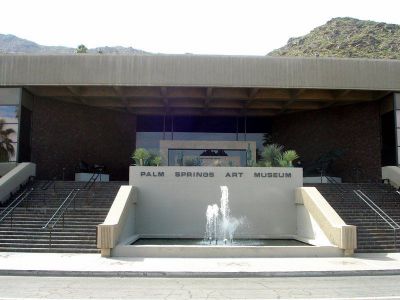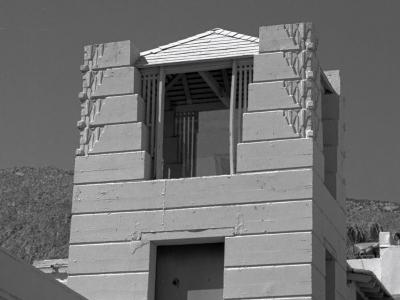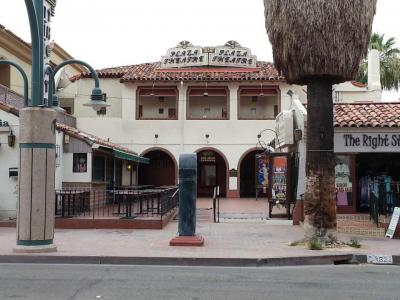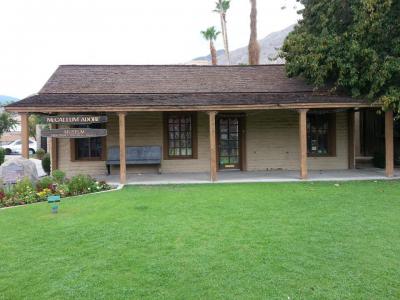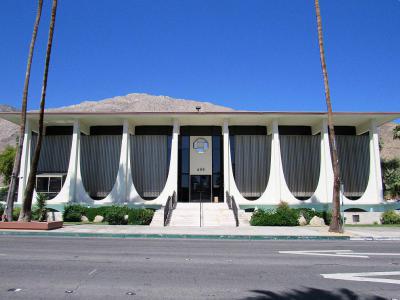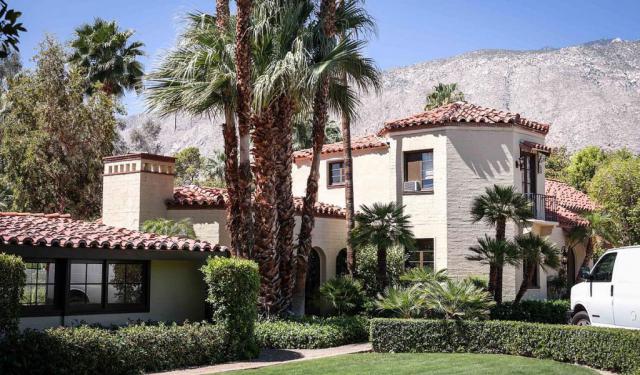Audio Guide: Palm Springs Introduction Walking Tour (Self Guided), Palm Springs
The Cahuilla people have lived in the Coachella Valley for over 2,000 years, long before the first European settlers showed up in the early 1800s. The area was popular because there was an abundance of water and shade here, rare commodities in the Sonoran Desert. Much of the land in and around Palm Springs is on the Agua Caliente Reservation; you can learn more about the Cahuilla at the Agua Caliente Cultural Museum.
During the 1800s, several settlers and pioneers settled in the area. Railroads passed nearby, but none close enough to make anything of the town. San Francisco attorney John Guthrie McCallum bought some property in the area and attempted to set up an irrigation system, but a series of floods and droughts thwarted his plans. The community remained small until the early 1900s when health tourism made it fashionable to seek out "dry heat," of which Palm Springs has an abundance.
Several resorts and hotels opened, and a resort town was born. Several upscale department stores from LA opened Spanish Colonial-style resort stores, followed by Southern California's first self-contained shopping center called La Plaza in 1936. Though the anchor stores have changed many times, you can still stroll La Plaza and see the original Plaza Theater.
Beginning in the 1930s, movie stars, singers, authors, and politicians flocked to Palm Springs. The town became known as the "Sandbox" for the rich and famous, a resort play-town in the desert. Several neighborhoods in town are chockablock full of homes owned or previously owned by the Hollywood glitterati. Strolling the sidewalks of the neighborhood of Old Las Palmas, for example, will reward you with views of the former vacation homes of Liberace, Elizabeth Taylor, Frank Sinatra, and Elvis, among many others.
Palm Springs is not the sleepy, out-of-the-way desert resort town it once was, but it's still a fantastic destination year-round. It's full of mid-century modernist architecture and wonderful historical gems for movie buffs (don't miss the Walk of Stars, Palm Springs' answer to the Hollywood Walk of Fame). Take a self-guided walking tour of Palm Springs, because you never know who you'll run into.
During the 1800s, several settlers and pioneers settled in the area. Railroads passed nearby, but none close enough to make anything of the town. San Francisco attorney John Guthrie McCallum bought some property in the area and attempted to set up an irrigation system, but a series of floods and droughts thwarted his plans. The community remained small until the early 1900s when health tourism made it fashionable to seek out "dry heat," of which Palm Springs has an abundance.
Several resorts and hotels opened, and a resort town was born. Several upscale department stores from LA opened Spanish Colonial-style resort stores, followed by Southern California's first self-contained shopping center called La Plaza in 1936. Though the anchor stores have changed many times, you can still stroll La Plaza and see the original Plaza Theater.
Beginning in the 1930s, movie stars, singers, authors, and politicians flocked to Palm Springs. The town became known as the "Sandbox" for the rich and famous, a resort play-town in the desert. Several neighborhoods in town are chockablock full of homes owned or previously owned by the Hollywood glitterati. Strolling the sidewalks of the neighborhood of Old Las Palmas, for example, will reward you with views of the former vacation homes of Liberace, Elizabeth Taylor, Frank Sinatra, and Elvis, among many others.
Palm Springs is not the sleepy, out-of-the-way desert resort town it once was, but it's still a fantastic destination year-round. It's full of mid-century modernist architecture and wonderful historical gems for movie buffs (don't miss the Walk of Stars, Palm Springs' answer to the Hollywood Walk of Fame). Take a self-guided walking tour of Palm Springs, because you never know who you'll run into.
How it works: Download the app "GPSmyCity: Walks in 1K+ Cities" from Apple App Store or Google Play Store to your mobile phone or tablet. The app turns your mobile device into a personal tour guide and its built-in GPS navigation functions guide you from one tour stop to next. The app works offline, so no data plan is needed when traveling abroad.
Palm Springs Introduction Walking Tour Map
Guide Name: Palm Springs Introduction Walking Tour
Guide Location: USA » Palm Springs (See other walking tours in Palm Springs)
Guide Type: Self-guided Walking Tour (Sightseeing)
# of Attractions: 11
Tour Duration: 2 Hour(s)
Travel Distance: 2.9 Km or 1.8 Miles
Author: Dee
Sight(s) Featured in This Guide:
Guide Location: USA » Palm Springs (See other walking tours in Palm Springs)
Guide Type: Self-guided Walking Tour (Sightseeing)
# of Attractions: 11
Tour Duration: 2 Hour(s)
Travel Distance: 2.9 Km or 1.8 Miles
Author: Dee
Sight(s) Featured in This Guide:
- Palm Springs Art Museum
- Palm Springs Walk of Stars
- La Plaza
- The Original Oasis Hotel Building
- Plaza Theatre
- Agua Caliente Cultural Museum
- Ruddy's General Store Museum
- McCallum Adobe and Cornelia White House
- Del Marcos Hotel
- Palm Springs Art Museum Architecture and Design Center
- Coachella Valley Savings No. 2
1) Palm Springs Art Museum (must see)
The museum began its life in 1938 as the Palm Springs Desert Museum, focusing on Native American art and the natural desert environment. In the 1950s and 1960s, the museum began a slow transition as more fine art was acquired. The result today is a truly unique museum experience, unlike any other in the world.
Alongside lots of great contemporary art in the form of paintings, photography, sculpture, and glass sculpture, you will find many objects representing the natural sciences. About half of the museum's 24,000 piece collection is dedicated to desert biology, geology, and archaeology.
The museum is also home to the 437-seat Annenberg Theater, which hosts renowned concert artists and performers. It also operates two satellite facilities, the Architecture and Design Center on Palm Canyon Drive and the Art Museum in Palm Desert. The Persimmon Bistro and Wine Bar is located next to the main museum's sculpture garden.
Why You Should Visit:
World class establishment with many special events throughout the year.
The art is well-grouped for viewing and appreciation, spacious and roomy to explore.
Tip:
Start on the topmost floor and work your way down to the main floor. Make sure to get to the fun basement, too!
Alongside lots of great contemporary art in the form of paintings, photography, sculpture, and glass sculpture, you will find many objects representing the natural sciences. About half of the museum's 24,000 piece collection is dedicated to desert biology, geology, and archaeology.
The museum is also home to the 437-seat Annenberg Theater, which hosts renowned concert artists and performers. It also operates two satellite facilities, the Architecture and Design Center on Palm Canyon Drive and the Art Museum in Palm Desert. The Persimmon Bistro and Wine Bar is located next to the main museum's sculpture garden.
Why You Should Visit:
World class establishment with many special events throughout the year.
The art is well-grouped for viewing and appreciation, spacious and roomy to explore.
Tip:
Start on the topmost floor and work your way down to the main floor. Make sure to get to the fun basement, too!
2) Palm Springs Walk of Stars (must see)
Located downtown along parts of Museum Drive, Tahquitz Canyon Way, and Palm Canyon Drive, the Walk of Stars is Palm Springs' answer to the Hollywood Walk of Fame. Stars are dedicated to important local figures, from famous residents, local philanthropists and humanitarians, and Medal of Honor recipients. It was started in 1992 with five stars and has now grown to include more than 400.
The main section of town along Palm Canyon Drive is a shopping and dining district, with great strolling and people watching. Palm Springs continues to surprise, and even as more luxury and chain brands move into the city, the place maintains its getaway village feel.
Around town, you will also find statues and monuments to other notable residents and city leaders. A few notable people mentioned include local businessman Pearl McCallum McManus and famous Hollywood icons like Marilyn Monroe, Liberace, Sophia Loren, Sonny Bono, and Elvis Presley.
Why You Should Visit:
Palm Springs has long been the getaway destination for the Hollywood elite. The Walk of Stars here is far less crowded than its western cousin but just as meaningful. You'll enjoy strolling along the main town streets and seeing how many names you recognize. It's partly a walk down memory lane and partly an excellent destination for some shopping or a fine meal.
Tips:
The noteworthy statue of Marilyn Monroe, Forever Marilyn, was set to be displayed permanently near the art museum. The statue has toured all over the world and has often appeared as a fixture in Palm Springs. Sculptor Seward Johnson designed the 26-foot tall, 34,000-pound statue. However, there's been some local controversy, and its ultimate fate is currently up in the air–much like Marilyn's dress.
The main section of town along Palm Canyon Drive is a shopping and dining district, with great strolling and people watching. Palm Springs continues to surprise, and even as more luxury and chain brands move into the city, the place maintains its getaway village feel.
Around town, you will also find statues and monuments to other notable residents and city leaders. A few notable people mentioned include local businessman Pearl McCallum McManus and famous Hollywood icons like Marilyn Monroe, Liberace, Sophia Loren, Sonny Bono, and Elvis Presley.
Why You Should Visit:
Palm Springs has long been the getaway destination for the Hollywood elite. The Walk of Stars here is far less crowded than its western cousin but just as meaningful. You'll enjoy strolling along the main town streets and seeing how many names you recognize. It's partly a walk down memory lane and partly an excellent destination for some shopping or a fine meal.
Tips:
The noteworthy statue of Marilyn Monroe, Forever Marilyn, was set to be displayed permanently near the art museum. The statue has toured all over the world and has often appeared as a fixture in Palm Springs. Sculptor Seward Johnson designed the 26-foot tall, 34,000-pound statue. However, there's been some local controversy, and its ultimate fate is currently up in the air–much like Marilyn's dress.
3) La Plaza
Between Palm Canyon and Indian Canyon Drives, you'll find La Plaza. It was initially called Palm Springs Plaza and was designed to be an open-air plaza at the center of town with shopping and dining. When it opened in 1936, it was one of Southern California's first shopping centers with one developer. It had a three-level parking lot that could hold 141 cars. The setting is unique and beautiful–Spanish Colonial-style shops and buildings are set with the gorgeous San Jacinto Mountains in the background. It shouts, “Palm Springs.”
Many anchor stores have come and gone from La Plaza, from Bullocks to Saks, and many in between. The Plaza Theater has been the only constant anchor, and it's still there today. This historic center is now home to many internationally-known brands as well as local delights. You'll find everything you could want in a small radius.
As you walk the nearby streets, don't forget to look down for memorials making up Palm Springs' Walk of Stars. All of the surrounding streets are included in the walk of fame, so keep an eye peeled for great finds. A statue of Sonny Bono, famous singer/songwriter, television actor, and politician, sits at the corner of La Plaza and Palm Canyon Drive.
Many anchor stores have come and gone from La Plaza, from Bullocks to Saks, and many in between. The Plaza Theater has been the only constant anchor, and it's still there today. This historic center is now home to many internationally-known brands as well as local delights. You'll find everything you could want in a small radius.
As you walk the nearby streets, don't forget to look down for memorials making up Palm Springs' Walk of Stars. All of the surrounding streets are included in the walk of fame, so keep an eye peeled for great finds. A statue of Sonny Bono, famous singer/songwriter, television actor, and politician, sits at the corner of La Plaza and Palm Canyon Drive.
4) The Original Oasis Hotel Building
In the 1920s, when Palm Springs was becoming the vacation boom town for the Southern California elite, Pearl McCallum McManus commissioned a new hotel to be built to house all of these visitors. He commissioned locally-renown architect Lloyd Wright, son of Frank Lloyd Wright, to design it. The result was the small but luxurious 24-room Oasis Hotel.
Wright was known for his modernist buildings, and the hotel was a decade or more before its time. It became the showpiece of the town–it even had the first swimming pool. Wright used stacking geometric concrete blocks to build the individual units, which were clustered around open courtyards. Ornamental wooden screens protected the rooms, which had large windows, from the blazing desert heat. The glass-walled dining room was built around existing cottonwood trees, with their limbs seeming to grow right into the building.
The Oasis Hotel opened in 1925 and was a smash hit. Stars like John Wayne, Lorette Young, and Clark Gable made the Oasis their getaway of choice and reinvented the little village around it. In the 1950s, the hotel was sold to Western Hotels, and much of the original property was dismantled or destroyed. Today, only the 40-foot decorative tower and a few construction blocks remain, tucked between businesses on Palm Canyon Drive. It is designated by the city as a Class I Historic site.
Wright was known for his modernist buildings, and the hotel was a decade or more before its time. It became the showpiece of the town–it even had the first swimming pool. Wright used stacking geometric concrete blocks to build the individual units, which were clustered around open courtyards. Ornamental wooden screens protected the rooms, which had large windows, from the blazing desert heat. The glass-walled dining room was built around existing cottonwood trees, with their limbs seeming to grow right into the building.
The Oasis Hotel opened in 1925 and was a smash hit. Stars like John Wayne, Lorette Young, and Clark Gable made the Oasis their getaway of choice and reinvented the little village around it. In the 1950s, the hotel was sold to Western Hotels, and much of the original property was dismantled or destroyed. Today, only the 40-foot decorative tower and a few construction blocks remain, tucked between businesses on Palm Canyon Drive. It is designated by the city as a Class I Historic site.
5) Plaza Theatre
The Plaza Theater was founded in 1936 by local businessman Earle C. Strebe. Like the rest of downtown and La Plaza, the theater was built in the Spanish Colonial style. As with many theaters from this era, the Plaza Theater hosted motion pictures and many live shows and performances. Many feature films held their world premieres here. The theater's opening show, "Camille," hosted stars Robert Taylor and Greta Garbo.
It was also an 800-seat playhouse. A famous annual show, the "Village Insanities," later renamed the "Village Vanities." Nationally-broadcast radio programs were hosted from the venue, and it provided a venue for all sorts of local events.
The theater went into a dormancy period in 1989, but the Fabulous Palm Springs Follies were founded. The critically-acclaimed show ran from 1990 to 2014.
The theater has sat unused since then. Recently, a local movement has begun plans to reopen the shuttered landmark. A groundswell of support for the old theater means that hopefully, it will come to life again soon. There are plans to completely renovate and revitalize the venue, with all new seating and infrastructure repairs.
It was also an 800-seat playhouse. A famous annual show, the "Village Insanities," later renamed the "Village Vanities." Nationally-broadcast radio programs were hosted from the venue, and it provided a venue for all sorts of local events.
The theater went into a dormancy period in 1989, but the Fabulous Palm Springs Follies were founded. The critically-acclaimed show ran from 1990 to 2014.
The theater has sat unused since then. Recently, a local movement has begun plans to reopen the shuttered landmark. A groundswell of support for the old theater means that hopefully, it will come to life again soon. There are plans to completely renovate and revitalize the venue, with all new seating and infrastructure repairs.
6) Agua Caliente Cultural Museum
The Agua Caliente Cultural Museum (ACCM) is a landmark institution in Palm Springs, dedicated to preserving and celebrating the rich heritage of the Agua Caliente Band of Cahuilla Indians. Located at the intersection of Tahquitz Canyon Way and South Indian Canyon Drive, the museum forms part of the Agua Caliente Cultural Plaza-an expansive site that includes the sacred Agua Caliente Hot Mineral Spring, a modern spa and bathhouse, tranquil gardens, and an oasis trail.
Originally founded in 1991, the museum was first located in the Village Green Heritage Center on South Palm Canyon Drive. In 2017, it became an official department of the Agua Caliente Band of Cahuilla Indians (ACBCI) Tribal Government, transitioning from a board-led institution to one governed by the ACBCI Tribal Council.
As the first Native American museum to be designated a Smithsonian Institution Affiliate, ACCM holds a unique place in American cultural heritage. Its exhibits and collections are deeply rooted in Cahuilla life, traditions, and values. Visitors can explore topics such as the long-standing importance of cattle and horses in Cahuilla livelihoods or dive into local lore with the exhibit Dream of the Blue Frog, which recounts the sacred history of the Hot Mineral Spring.
The museum’s architectural design is equally symbolic. Master planning began in 2015, with JCJ Architecture and Jones & Jones Architects drawing inspiration from traditional Cahuilla basketry. The building’s curved form represents a "basket start," or the first coils of a handmade basket-an homage to one of the community's most iconic artforms.
The Agua Caliente Cultural Museum features three main collections: Objects and Artifacts, including baskets, pottery, and artwork by Cahuilla and other Southern California tribes; Archives, with oral histories, photos, and documents on Cahuilla life; and a Library focused on Indigenous cultures, especially Cahuilla history and research.
With the completion of the Cultural Plaza in 2023, the museum now offers an immersive environment where tradition meets modern storytelling, all anchored by the living presence of the sacred spring and the enduring voice of the Agua Caliente people.
Why You Should Visit:
To learn about the native culture, and to get an insight into how early inhabitants were able to live in this desert.
Tip:
Check out the lovely garden in the back, which relates to many plants used by the area's early, tribal residents, and consider visiting the nearby Indian Canyons afterward.
Originally founded in 1991, the museum was first located in the Village Green Heritage Center on South Palm Canyon Drive. In 2017, it became an official department of the Agua Caliente Band of Cahuilla Indians (ACBCI) Tribal Government, transitioning from a board-led institution to one governed by the ACBCI Tribal Council.
As the first Native American museum to be designated a Smithsonian Institution Affiliate, ACCM holds a unique place in American cultural heritage. Its exhibits and collections are deeply rooted in Cahuilla life, traditions, and values. Visitors can explore topics such as the long-standing importance of cattle and horses in Cahuilla livelihoods or dive into local lore with the exhibit Dream of the Blue Frog, which recounts the sacred history of the Hot Mineral Spring.
The museum’s architectural design is equally symbolic. Master planning began in 2015, with JCJ Architecture and Jones & Jones Architects drawing inspiration from traditional Cahuilla basketry. The building’s curved form represents a "basket start," or the first coils of a handmade basket-an homage to one of the community's most iconic artforms.
The Agua Caliente Cultural Museum features three main collections: Objects and Artifacts, including baskets, pottery, and artwork by Cahuilla and other Southern California tribes; Archives, with oral histories, photos, and documents on Cahuilla life; and a Library focused on Indigenous cultures, especially Cahuilla history and research.
With the completion of the Cultural Plaza in 2023, the museum now offers an immersive environment where tradition meets modern storytelling, all anchored by the living presence of the sacred spring and the enduring voice of the Agua Caliente people.
Why You Should Visit:
To learn about the native culture, and to get an insight into how early inhabitants were able to live in this desert.
Tip:
Check out the lovely garden in the back, which relates to many plants used by the area's early, tribal residents, and consider visiting the nearby Indian Canyons afterward.
7) Ruddy's General Store Museum (must see)
Ruddy's General Store Museum is a small building that recreates a 1930's town general store with an uncanny level of detail. The store’s shelves are lined with the contents from one private collection. Most of the items on display are still intact with their original products inside. Everything is original, dating from 1890 to 1945.
The store was a creation by Jim Ruddy, a Palm Springs resident and collector. In 1983, on a trip to mid-west, Ruddy came across a museum with a collection of Depression-era products and merchandise. He bought the collection and used the items to create this little fun museum. In 2003 he donated the entire museum to the city of Palm Springs. Today the museum is one of the most popular spots in the city.
Why You Should Visit:
You can't buy anything–this is a glimpse at the past, not a functioning store. But it is fun to compare and contrast what the shopping experience was like a century ago with what we're used to now.
Tips:
Ask the docent about their favorites or the most interesting items in the store–you're sure to get a good story.
The cost of entry is only $1, and it's well worth it. It's small, so don't expect to take very long. It's a wonderful stop whether you're passing by or just looking for a place to get out of the sun for a while.
The store was a creation by Jim Ruddy, a Palm Springs resident and collector. In 1983, on a trip to mid-west, Ruddy came across a museum with a collection of Depression-era products and merchandise. He bought the collection and used the items to create this little fun museum. In 2003 he donated the entire museum to the city of Palm Springs. Today the museum is one of the most popular spots in the city.
Why You Should Visit:
You can't buy anything–this is a glimpse at the past, not a functioning store. But it is fun to compare and contrast what the shopping experience was like a century ago with what we're used to now.
Tips:
Ask the docent about their favorites or the most interesting items in the store–you're sure to get a good story.
The cost of entry is only $1, and it's well worth it. It's small, so don't expect to take very long. It's a wonderful stop whether you're passing by or just looking for a place to get out of the sun for a while.
8) McCallum Adobe and Cornelia White House (must see)
Two incredible historic houses sit together, managed by the Palm Springs Historical Society. The houses themselves also contain artifacts from Palm Springs' past, such as the first telephones in the area.
The McCallum Adobe was the home of the first European American settler in the area. It was built in 1884, and it was the first adobe structure built in the area.
The Cornelia White house is a wooden home built in 1893. It's unique in that it is built entirely from railroad ties. The ties came from the Palmdale Railroad, a horse-drawn railroad that connected Palm Springs to Palmdale, abandoned in 1893.
Why You Should Visit:
Both houses provide a glimpse into what life was like in nineteenth-century Palm Springs. The two structures are the two oldest buildings in town.
The houses have been fully restored by the historical society, with artifacts from the time that tell the story of early pioneers in town. You'll see not only what living here was like, but also learn a little more about the town and why people came here.
Exhibits inside also feature notable town visitors, focusing on Hollywood starlets from the 1930s to 1950s.
Tips:
The homes are small, as most houses were in those days, so you don't need very long to see them. This is an excellent stop if you need a fill up a few minutes or get out of the heat. Admission is free, and you can see everything in under an hour.
The McCallum Adobe was the home of the first European American settler in the area. It was built in 1884, and it was the first adobe structure built in the area.
The Cornelia White house is a wooden home built in 1893. It's unique in that it is built entirely from railroad ties. The ties came from the Palmdale Railroad, a horse-drawn railroad that connected Palm Springs to Palmdale, abandoned in 1893.
Why You Should Visit:
Both houses provide a glimpse into what life was like in nineteenth-century Palm Springs. The two structures are the two oldest buildings in town.
The houses have been fully restored by the historical society, with artifacts from the time that tell the story of early pioneers in town. You'll see not only what living here was like, but also learn a little more about the town and why people came here.
Exhibits inside also feature notable town visitors, focusing on Hollywood starlets from the 1930s to 1950s.
Tips:
The homes are small, as most houses were in those days, so you don't need very long to see them. This is an excellent stop if you need a fill up a few minutes or get out of the heat. Admission is free, and you can see everything in under an hour.
9) Del Marcos Hotel
The Del Marcos was designed by William F. Cody in 1947 and is one of the few Mid-Century hotels still up and running. With the gorgeous San Jacinto Mountains in the background, the Del Marcos is one of the most photographed buildings in town. With a stay here, or even just stopping by to have a look, and it's easy to imagine yourself a Hollywood star, vacationing away from the LA madhouse.
The Del Marcos is currently operating as a boutique hotel, with period furnishings that complete the Mid-Century ambiance. It's located only one block from downtown. It's a highly sought-after location for its retro, laid-back vibe, and the current management does a beautiful job of maintaining the hotel's ambiance. It's an adult-only property featuring daily happy hours with cocktails and appetizers around the pool. Pretty much every room has a stellar view of the pool and the mountains in the background.
The Del Marcos Hotel was declared as a Class 1 historic site by Palm Springs City Council in May 2012.
The Del Marcos is currently operating as a boutique hotel, with period furnishings that complete the Mid-Century ambiance. It's located only one block from downtown. It's a highly sought-after location for its retro, laid-back vibe, and the current management does a beautiful job of maintaining the hotel's ambiance. It's an adult-only property featuring daily happy hours with cocktails and appetizers around the pool. Pretty much every room has a stellar view of the pool and the mountains in the background.
The Del Marcos Hotel was declared as a Class 1 historic site by Palm Springs City Council in May 2012.
10) Palm Springs Art Museum Architecture and Design Center
A satellite facility of the Art Museum, the Architecture and Design Center is housed in a former bank building. The vault and teller drive-through are still present from its days as the Santa Fe Federal Savings and Loan. It's a small facility that rotates single exhibits.
Exhibitions rotate through either the design or architecture theme, so don't expect to see both. It's a quick stop, and with rotating exhibits, it's impossible to know what you'll find. And that's precisely the appeal of this small gallery and exhibition space located right downtown. Pop in and see what they're showing. It's a great place to relax and get out of the heat. Docents are present, and video tours help discuss the artwork.
The bank's vault has been turned into the museum gift shop, which features books related to architecture and design. There's also a selection of modern jewelry and objects and accessories representing modern design.
Tips:
Regular admission is five dollars, but you can apply that amount to the main Art Museum admission. There are free days offered on Thursdays afternoons, so stop by and see what's being offered.
Exhibitions rotate through either the design or architecture theme, so don't expect to see both. It's a quick stop, and with rotating exhibits, it's impossible to know what you'll find. And that's precisely the appeal of this small gallery and exhibition space located right downtown. Pop in and see what they're showing. It's a great place to relax and get out of the heat. Docents are present, and video tours help discuss the artwork.
The bank's vault has been turned into the museum gift shop, which features books related to architecture and design. There's also a selection of modern jewelry and objects and accessories representing modern design.
Tips:
Regular admission is five dollars, but you can apply that amount to the main Art Museum admission. There are free days offered on Thursdays afternoons, so stop by and see what's being offered.
11) Coachella Valley Savings No. 2
This building has housed several banks over its history. It has been known as the Coachella Valley Savings and Loan Association, a Washington Mutual, and currently a Chase Bank. The structure is the interesting part. It was built in the 1960s and designed by E. Stewart Williams in the International style. It lacks much ornamentation. It is distinctive, though, with inverted arches that form columns that hold up the flat room. The bank sits in front of a reflecting pool with fountains. The Classical symmetry of the facade is considered to be a nod to New Formalism.
The unique design, besides being beautiful, served two purposes. It provides an immense amount of open floor space inside, without the need for interior columns. It also provided the strength and stability needed to survive seismic events.
The building is listed on the National Register of Historic Places. Besides being updated for an ATM and disabled access, the building is unchanged. It is referred to as Coachella Valley Savings and Loan No. 2 because it was the second branch and the second one designed by Williams. The first was a few blocks north.
The unique design, besides being beautiful, served two purposes. It provides an immense amount of open floor space inside, without the need for interior columns. It also provided the strength and stability needed to survive seismic events.
The building is listed on the National Register of Historic Places. Besides being updated for an ATM and disabled access, the building is unchanged. It is referred to as Coachella Valley Savings and Loan No. 2 because it was the second branch and the second one designed by Williams. The first was a few blocks north.
Walking Tours in Palm Springs, California
Create Your Own Walk in Palm Springs
Creating your own self-guided walk in Palm Springs is easy and fun. Choose the city attractions that you want to see and a walk route map will be created just for you. You can even set your hotel as the start point of the walk.
Famous Houses in Palm Springs
Since the early 1930s, Palm Springs, California, has been a favorite desert oasis for the Hollywood elite. With its excellent winter and springtime weather, fabulous shopping, and beautiful overall ambiance, this place offered celebrities a convenient escape from clamoring photographers and newspaper gossip.
Here, behind the private walls of homes and bungalows, the stars could feel relaxed... view more
Tour Duration: 3 Hour(s)
Travel Distance: 7.2 Km or 4.5 Miles
Here, behind the private walls of homes and bungalows, the stars could feel relaxed... view more
Tour Duration: 3 Hour(s)
Travel Distance: 7.2 Km or 4.5 Miles
The Most Popular Cities
/ view all



